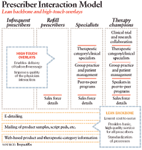Sewing Up New Sales
Pharmaceutical Executive
More than high-call frequency will be necessary to succeed in an increasingly competitive sales environment.
If you look at pharmaceutical companies' traditional sales and marketing practices, you might think that all customers are identical. Why else would they treat all physicians nearly the same? In fact, there are many important differences between prescribers, even within the same specialty in the same town. Some are early adopters of new drugs and technology. Others take longer to be convinced. Many physicians are active participants in the sales process: They speak at peer-to-peer functions and lecture about the diseases they know well. Other doctors don't even like to see sales reps.
That said, almost every physician wants a few of the same things from pharma sales and marketing departments. Samples are almost always popular. And even practices that ban reps altogether want good, accessible product information.

Interaction Preferences
So can pharma design an approach to fit all of its customers? Probably not. And based on sales practices in other industries—where "one-size-fits-all" approaches have given way to tailored, more flexible sales and marketing models—pharmaceutical companies probably need to step away from traditional "reach and frequency" methods. More than high-call frequency will be necessary to succeed in an increasingly competitive sales environment.
Strong prescriber relationships will be a key source of competitive advantage in the years ahead. To build these relationships, companies should rethink prescriber requirements to tailor their sales approach to the disparate needs and attitudes of physicians.
But first, companies need to look for ways to meet needs that otherwise different groups of prescribers have in common. These prescriber interactions, which typically include simple transactions like providing product samples, sharing basic product information, and e-detailing, present opportunities for standardization. Centralized, cost-effective, and consistent delivery of these basic services should be a core function of sales and marketing—it is the "lean backbone" of a marketing strategy.
When every customer has access to these basic services, additional features can be tailored to meet more specialized needs. These "high-touch overlays" satisfy more exacting prescriber demands and deliver tailored messages cost effectively to specific groups of physicians.

Prescriber Interaction Model
To develop such a multi-tiered marketing strategy, pharma companies need to take certain steps:
IDENTIFY PRESCRIBER SEGMENTS Physicians need much more than information from pharmaceutical companies and their reps. Thought leaders within a therapeutic category, for example, might want to get involved in clinical trials, speak at peer-to-peer events, and get help determining which patients would benefit most from a product. In general we distinguish four types of primary care physicians:
- Independents Nearly a quarter of prescribers see little value in interactions with pharmaceutical companies
- Transactionals Nearly one-in-four physicians see pharma as a source of samples, tend to be motivated by patient preferences, and are slow to try new drugs
- Knowledge seekers About one-in-five GPs are interested in educational programs but less keen on samples or personal interactions with reps
- Relationship seekers One in three MDs look forward to visits from reps, value educational programs and samples, and tend to be early adopters of medication.
CREATE A STANDARDIZED, LOW-COST BACKBONE The "lean backbone" comprises the set of sales and marketing activities that a pharma company has to perform across its entire product portfolio, which can be standardized and streamlined. This represents the bare minimum of service that the company would provide to prescribers, primarily information and "self-serve" transactions. These might include:
- Online therapeutic category and product information for all products in a company's portfolio
- Dedicated portals designed to generate disease-state awareness and meet the specific information needs of the physician, nurse, pharmacist, managed care company, and caregiver
- Online help, 24 hours a day, from dedicated call-center representatives
- E-details for physicians who are hard to see or for whom additional coverage is not cost-effective
- Centralized mailing of product samples, script pads, etc.
DEVELOP "HIGH-TOUCH OVERLAYS" for delivering tailored messages to prescribers who value higher levels of sales and service support, and have prescribing potential that's high enough to cover the cost. "High-touch" services include:
- In-person field sales calls
- Group practice and patient case management
- Peer-to-peer programs, including speaker selection and training
- Trial and research collaboration
- In-depth clinical information.
None of these approaches are new or unique to pharma. Several large companies use multifunctional, multidivisional teams with senior executive leadership to drive sales. More than salespeople, these executives seek selling solutions rather than individual product sales.

Personal Messages
In December 2005, The Pink Sheet reported that Eli Lilly is using "portfolio specialist" reps to engage with "no-access institutions"—those that refuse to see standard reps. John Lechleiter, Lilly's COO, said, "Portfolio specialists are single points of contact for these customers, providing product and disease-state knowledge, samples, and referrals to outside expertise." According to Lechleiter, portfolio specialists are helping Lilly get "back in the door."
Financial services company Charles Schwab & Co. does a superb job of segmenting and providing high-touch services. Frontline retail staffers are trained to categorize customers by segment. The company guides them to the appropriate channels. Everyone has access to the backbone of services, which includes easy-to-use online access to accounts. More sophisticated investors get access to more information, while the most affluent get personal attention from independent advisors.
Similarly, Dell was among the first companies in the computer industry to recognize wide variations in what customers want from marketing, from simple transactions to in-depth consultative services.
Our research has shown similar—and growing—variations in what physicians want from pharma sales reps, but many pharma companies have yet to adjust their marketing "touches" accordingly.
Better Product Launches
This new physician-interaction model can help pharmaceutical companies achieve more profitable growth and provide additional value to prescribers. A disciplined, investment-oriented approach based on prescribers' bottom-line value will allow companies to align cost-to-serve with expected value.

The benefits of the model are likely to be magnified for growth products early in their lifecycles, when effective promotion will have the greatest impact in shaping long-term physician perceptions and prescribing behavior. And high-touch overlays play a crucial role in launches, primarily to help the product message reach early adopters and key opinion leaders. A high-level blitz of touches is vital in the critical six-month period after launch, when physician perceptions are established and the eventual peak uptake of the product is determined.
Adaptive Implementation
Developing a winning physician-interaction model isn't easy. Any change to the existing approach is a bold step, particularly for companies anticipating imminent product launches or promoting recently launched growth products.
The physician-interaction model for each company should be optimized for a given product and customer mix. Small-scale pilots, run before a national rollout, should test and refine key implementation and sequencing considerations, such as segmenting customers based on interaction needs, building the lean backbone and necessary skills for high-touch overlays and tailored messages.
Recent technological advances make it possible to measure prescriber behaviors in real time. Traditional measures, such as TRx/NRx (total vs. new prescriptions), can now be combined with "point-of-prescribing" data and physician feedback on detail execution. Metrics include office access relative to competitors, message believability, visual-aid usage, and intent to prescribe. These measures can help control "external" influences, including geographical differences in managed care status, and inform adjustments to the prescriber-interaction model.
Next Generation Sales Metrics
Pharma's next generation of sales and marketing will rely on techniques pioneered by consumer packaged-goods companies. By gathering metrics at the point of promotion and prescribing, pharma can improve its commercial efforts. Some companies already obtain regular physician feedback on detail execution and rep quality, to determine what truly influences physician brand choice. The new metrics allow companies to adjust brand messages and detailing strategies based on precise, timely feedback from targeted physicians.

Keeping Track
Mobile hand-held technology has changed the game. Using hand-held data-collection tools supplied by pharma, physicians can report on all promotional activity. By equipping physicians with PDAs or smart phones, pharma companies can economically track a significantly greater percentage of sales-rep office visits—and measure the impact on physician behavior in real time, including office-based (written) prescription sales.
Sales-force performance models based on rep-reported data are missing a key ingredient for analysis: the role played by competitive details in changing physician behavior. Data collected from physician customers via an "always-on" PDA system provides sales managers with feedback they can confidently compare with industry and competitive benchmarks.
For years, sales force performance was measured by comparing performance of one company with another—often on an annual basis. The most sophisticated sales teams are now using detail execution and sales rep quality metrics to:
- Compare monthly or quarterly performance of regions over time with national averages
- Benchmark regions against competitors, not just other company regions or national averages
- Break down sales performance by company brand, to account for important differences across therapeutic classes
- Modify incentive compensation for regional managers to incorporate customer feedback.
Integrating metrics across promotional channels can allow a company to optimize the marketing mix. When using lean backbone and high-touch overlays, companies must measure not only the ROI of each promotional channel, but also the interaction between channels.
For example, instead of measuring the ROI of e-detailing alone, the new metrics can allow a company to understand how e-detailing might change the impact of other activities, such as sales-force detailing. Best-in-class firms will customize integrated metrics for each physician segment so that they can optimize the marketing mix at the segment level.
Sales and brand managers should pay special attention to the share of patients who are newly diagnosed and switching for the first time ("written Rx"), since this is the "dynamic" market segment most subject to promotion. Written Rx is the purest measure of promotional effectiveness, since it occurs before formularies and patient behaviors erode the number of prescriptions. Comparing written Rx with pharmacy-dispensed Rx (NRx) can reveal how much "leakage" is occurring outside the doctor's office.
Focusing on a brand's share of the dynamic market quickly generates the feedback needed to adjust tactics in a fast-paced marketplace. Using the new written Rx as the dependent variable enables teams to identify what's working and what's not, including:
- Detail and patient characteristics, and sales-rep attributes, that drive increased market share for specific brands
- Impact of messages delivered by sales reps about the markets of a brand and its competitors
- Correlation of rep activity and ratings with adoption patterns for new products and indications.
Cross-Integration
New customer-driven sales metrics are connecting previously siloed parts of pharma organizations. Sales, marketing, and managed care groups are collaborating based on a common data set. The three groups can compare notes on marketplace, company, and competitor performance, since new data make discussions with their counterparts fruitful; they can hold each other accountable. Here's how this would work:
- A sales manager uses competitive detailing data from a PDA-based, longitudinal network of primary care physicians to show his marketing counterpart how his team delivers higher share of voice following a sales-force expansion. The two managers collaborate regularly and closely to drive brand performance
- A Big Pharma marketing team use PDA-based data to monitor the sales team's delivery of primary and secondary messages. The large sample size of over 600 details per brand per month increases the confidence of both the sales and marketing teams in the accuracy and actionability of the information
- A pharma company compares written Rx to NRx shares to better understand the managed care position of a key brand. The managed care group works closely with the marketing and sales teams to benchmark performance, establish a new strategy, and reallocate field resources based on managed care access.
A new sales model requires companies to adapt to the needs of different physician segments. The learning curve associated with the model is steep. A multiyear rollout that tracks progress with appropriate sales metrics may work better than an abrupt, one-time change in the commercial model. Even so, incumbents may find the transition to the new model difficult, since the marketplace has changed and the players must take risks and adapt or pay the consequences. For those companies that succeed, however, the payoff is great.
David Stievater is VP, business development, for ImpactRx. Alexander Petersen is associate principal and Rahul Bhatia is engagement manager for McKinsey & Co.

The Misinformation Maze: Navigating Public Health in the Digital Age
March 11th 2025Jennifer Butler, chief commercial officer of Pleio, discusses misinformation's threat to public health, where patients are turning for trustworthy health information, the industry's pivot to peer-to-patient strategies to educate patients, and more.
Navigating Distrust: Pharma in the Age of Social Media
February 18th 2025Ian Baer, Founder and CEO of Sooth, discusses how the growing distrust in social media will impact industry marketing strategies and the relationships between pharmaceutical companies and the patients they aim to serve. He also explains dark social, how to combat misinformation, closing the trust gap, and more.